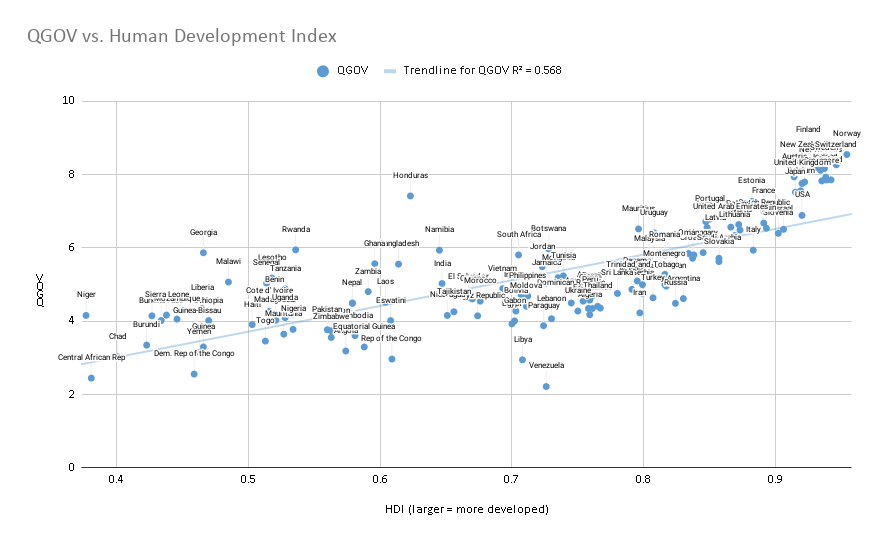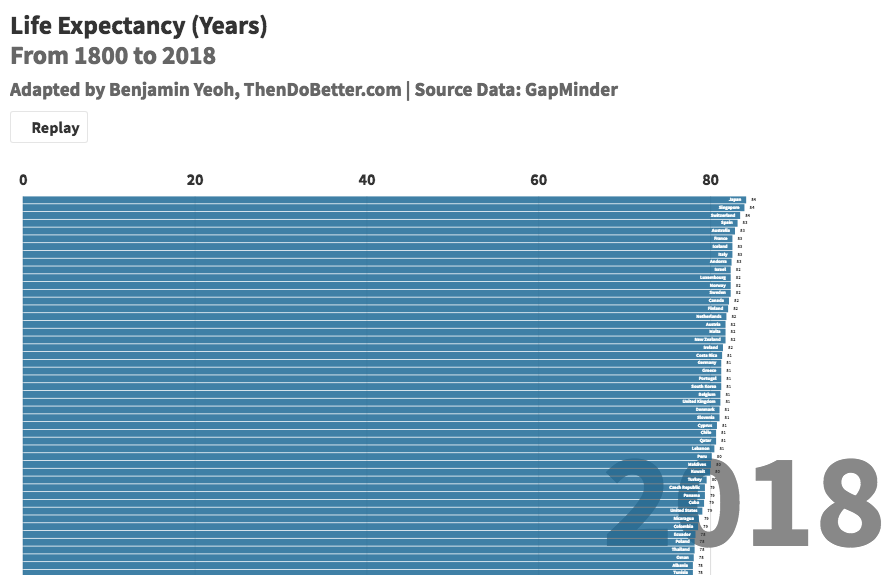“...It’s not the size of the wave but the motion of the ocean…”
Quality of government (QGOV) seems more important than size of government (SGOV) for a variety of domains
QGOV is more important for peace, for human development, for health and for education
This exploratory work extends the work of Ed Dolan (Niskanen Centre) and comes with many caveats due to interactions.
Outliers such as Singapore and Ireland may be worth closer examination for what is working well in smaller governments
QGOV may have increasing importance at higher levels of development
This may provide exploratory evidence that “state capacity” in certain domains eg innovation, health and education - might be important. This adds to the debate on “state capacity libertarianism” and in terms of current UK policy may inform on whether investing in an “ARPA organisation” or other areas of state capacity is a positive return on investment.
Background
Economist Tyler Cowen posited a notion of State Capacity Libertarianism. Cowen subsequently linked to a blog referencing the work of Ed Dolan.
The work (2017) developed two scores - QGOV for quality of government and SGOV for size of government. Dolan analysed two measures of freedom and prosperity the Legatum Prosperity Index and the Cato Human Freedom Index and concluded - with several caveats due to interactions and unknown causality- that QGOV was more important than SGOV. See his work for definitions of SGOV and QGOV.
Idea
I was intrigued if this work extended to other areas that I am interested in both personally and professionally. (I help allocate $13bn in pension fund and other investments in global equities with an interest in healthcare).
I chose to look at:
-Peace
-Human Development
-Life Expectancy (as broad measure for health)
-Education
As measured by other organisations.
Methods
I hand inputted data on:
SGOV, QGOV,
Human Development Index (UN HDI)
Education Index (EDI, as component of HDI)
Life expectancy Index (as component of HDI)
Peace index (as calculated by non-profit Vision of Humanity)
(Sources at end, errors possible)
I ran scatter plots and Pearson correlations. I tagged for World Bank classifications of income, and by geographic region.
Results
QGOV vs Peace
Correlation = (-) 0.71 | R2 = 0.5
Higher quality of government had a 0.7 correlation with the Peace Index (where lower score = more peace)
An interactive version of this data, where you can also view by income level (use drop down box) and geography (click circle legend labels) is below. The trend holds for all levels of income.
SGOV vs Peace
Correlation = 0.32 | R2 = 0.1
Size of government had a weaker 0.3 correlation with the Peace Index (where lower score = more peace)
The overall correlation is weaker and also suggestive that large governments correlate slightly with the peace index.
An interactive version of this data, where you can also view by income level (use drop down box) and geography (click circle legend labels) is below. Different income levels change the trend line, upper middle level countries inverting - suggesting smaller govts here are better for peace but only weakly.
Geography also changes the trend, with Latin America countries suggesting smaller very weakly trending. It’s weak enough maybe to be considered almost no trend though.
My overall takeaway is that the trend is weak vs QGOV but it is intriguing that income levels change the pattern as do geography.
Peace comment
As often there are intersections on what components might go into peace. Experts may disagree as to the validity of this index for peace however the methodology is clear and it has some support.
I find it interesting as it is another lens to judge human “progress” on and therefore what types of government might best foster progress.
QGOV vs HDI, Human Development Index
Correlation = 0.75 | R2 = 0.57
Quality of government has a 0.75 correlation with the Human Develpment Index where larger HDI = more developed.
It looks to me that the slope is stronger in more developed nations. Gently sloping until about 0.75 on HDI, and then steeper.
An interactive version of this data, where you can also view by income level (use drop down box) and geography (click circle legend labels) is below. You can observe this as the slope is stronger for the richer nations (and a measure of GNP is included within the HDI) but it is the same direcction for all incomes, slightly weak for middle.
SGOV and HDI
Correlation = -0.53 | R2 = 0.28
Size of government has a -0.5 correlation with the Human Develpment Index (where larger HDI = more developed) suggesting larger governments are moderately better than small governments with some notable outliers such as Singapore, South Korea and to some extent Ireland, and Switerland.
An interactive version of this data, where you can also view by income level (use drop down box) and geography (click circle legend labels) is below.
The trends are weaker split by income level, with there almost no trend in high income and upper-middle income.
I now present the components for life expectancy and education (that go into the HDI seperately).
QGOV vs EDI
Comments on EDI, Life expectancy; observations and arguments for state capacity.
Given the weighting in the HDI that life expectancy has, it is unsurprising that QGOV also correlates better than SGOV for life expectancy.
While there are social and cultural determinants of health of which government would only be a component, I argue that it is still noteworthy that it is not size but quality of government here that seems to count.
Again given the weighting in the HDI for Education, it is again unsurprising that QGOV correlates better than SGOV.
Of note, Chile and Kazakhstan appear on education and to some extent life expectancy as higher perfomer small government countries to join Singapore and Ireland, Switerland.
I chose to examine education and health because in many countries there is on going debate as to the structure and capacity that governments should play in health and education markets.
This line of argument would suggest where countries do wish their governments to be involved then quality of that government or perhaps “state capacity” could be an important factor.
This is noteworthy in the UK where there is wide support for a National Health service across the political divide and also for state funded education providing the majority of the populations education.
Two other tentative observations. It is worth dwelling on where small governments seem to be doing well. I would note Singapore and South Korea and perhaps to an extent Ireland and Switerland. Those countries would be good examples of small, high quality goverments.
My own theory here is also the importance of social and cultural determinants of health and education.
For instance, it is unknown what the compliance rate for medications are in various countries. A higher drug medication compliance of cost effective genetic medications in Singapore (arguable driven by a social factor of listening to your doctor properly?!) or of the positive/negative health outcomes of effective elderly social care across countries are mostly unknown.
A second observation is the seemingly stronger slope in the high HDI nations. There may be many explanations for this and all the caveats expressed by Dolan also apply but it might be an intriguing provocation that quality of government becomes even more important in extending the progress of already highly developed countries.
Caveat
As Dolan notes there is considerable interation between SGOV and QGOV as larger governments have a tendency to be of better quality, but Dolan runs multiple regressions here:
“…simple correlations like this need to be interpreted with caution, as there are complex intercorrelations among multiple variables. In this case, we have a correlation of -0.42 between SGOV and QGov, that is, a tendency for larger governments to have a higher index of quality. We also have a correlation of 0.74 between QGOV and the log of GDP per capita (richer countries have higher-quality governments) and -0.48 between SGOV and the log of GDP per capita (richer countries have relatively larger governments).
Dolan can run multiple regressions which I do not have the capcity for, but Dolan concludes:
We can use multiple regression to untangle these interactions, using HFI* as the independent variable and using QGOV, SGOV, and the log of GDP per capita as the dependent variables. When we do so, we get a strongly statistically significant positive coefficient on QGOV and no statistically significant relationship at the 0.01 confidence level for the other two variables. The overall correlation is 0.79, essentially the same as for the two-variable relationship shown in the left-hand scatter plot above…”
I suspect multiple regressions would confirm similar and hope a profesional academic might look into this
Conclusion
I tentatively extend the work of Dolan on the size of government and quality of government to look at four further broad indices of 1) peace, 2) human development, 3) education and 4) life expectancy.
In all four cases, quality of government seems to be a more important factor than the size of government. This would be tentative evidence for theories that emphasise the importance of quality - perhaps state capacity - over the size of the state, where societies favour a state role in any given area.
Notes and Caveats
Data sheet link available on request. It’s not very tidy but all in good faith. Image below. I may have made errors in the data, as it’s my late night pet -project.
Do read the Ed Dolan Caveats in his blog but repeated here.
“...As in any statistical study, we should be cautious about drawing conclusions about causation. There is nothing in these results to suggest that making a country’s government bigger will automatically make it better. At the same time, it is hard to deny that there is a strong tendency in the cross-country data for larger governments to be better governments, when by “better,” we mean better able to protect property rights, better able to offer impartial civil and criminal justice, and less open to corrupt influences.
Readers are also encouraged to think about the country-by-country data reported in the chart and table above. There is a lot of variety in the world. Too strong a focus either on statistical regularities or on selected outliers can draw us too strongly toward conclusions that, in reality, admit of many exceptions.
For example, the small-government city states of Singapore [is] rightly admired for [its] prosperity and economic freedoms. However, it gives one pause to note how many small-government countries enjoy neither. Chad, Bangladesh, and the Democratic Republic of Congo are just the outliers among a whole cluster of countries in that category.
Similarly, a look at individual countries shows that our statistical indicators of “big” and “small,” or of “good” and “bad,” do not always line up with what we mean by these terms in other contexts. For example, many people in the West would readily name Russia and China as countries with governments that are conspicuously both big and bad. Yet, although Russia and China do fall into the southwest quadrant of our chart, they do so only barely. Statistically speaking, neither country is an outlier on either variable…]
Ed Dolan’s two part blog on SGOV and QGOV.
Peace Index can be found here: http://visionofhumanity.org/indexes/global-peace-index/
Human Development Index and components (both the education and life expectancy - I use 2018 data - ) can be seen here: http://hdr.undp.org/en/data
World Bank Classificatinos are from 2016 (as the 2018 xls wasnt’ working when I compiled the data). The Visuals are H/T Flourish Studios and Google Sheets.
Tyler Cowen on State Capacity Libertarianism
The Table of data I used is below.























